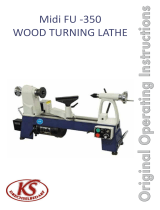19
PL
Spis tresci
Wstęp ........................................19
Przeznaczenie ............................ 19
Opis ogólny ...............................20
Zawartość opakowania ..................20
Opis działania ..............................20
Przegląd .......................................20
Dane techniczne ......................... 21
Zasady bezpieczeństwa ............. 21
Symbole i piktogramy .....................22
Ogólne zasady bezpieczeństwa
dotyczące narzędzi elektrycznych....22
Uwagi dotyczące bezpieczeństwa dla
wiertarek stołowych
.......................24
Montaż ...................................... 26
Obsługa.....................................26
Ustawienie urządzenia ...................27
Wybór prędkości obrotowej ............27
Kontrola paska klinowego ...............27
Naprężanie pasa klinowego ...........28
Ustawianie stołu wiertarskiego ........28
Ustawianie głębokości wiercenia .....28
Wymiana narzędzia ......................28
Wiercenie .....................................29
Uwagi ogólne ...............................29
Załączanie i wyłączanie .................29
Mocowanie obrabianego elementu ..29
Usuwanie blokad ...........................29
Czyszczenie i konserwacja .........30
Czyszczenie ..................................30
Przechowywanie urządzenia .....30
Usuwanie i ochrona środowiska 31
Części zamienne / Akcesoria ......31
Poszukiwanie błędów ................32
Gwarancja ................................. 33
Serwis naprawczy .....................34
Service-Center ............................34
Importer ....................................34
Tłumaczenie oryginalnej deklaracji
zgodności WE...........................114
Rysunek samorozwijający
........121
Wstęp
Gratulujemy zakupu nowego urządzenia.
Zdecydowali się Państwo na zakup warto-
ściowego produktu. Niniejsze urządzenie
sprawdzono w trakcie produkcji pod kątem
jakości, a także dokonano jego kontroli
ostatecznej. W ten sposób zapewniona jest
jego sprawność. Nie da się wykluczyć tego,
że w pojedynczych przypadkach w urzą-
dzeniu lub przy nim wzgl. w wężach mogą
się znaleźć pozostałości wody lub smaru.
Nie jest to brakiem ani uszkodzeniem, czy
powodem do troski o urządzenie.
Instrukcja obsługi jest częścią skła-
dową produktu. Zawiera ona waż-
ne wskazówki dotyczące bezpie-
czeństwa, eksploatacji i utylizacji.
Przed rozpoczęciem użytkowania
produktu należy się zapoznać ze
wszystkimi wskazówkami dotyczą-
cymi obsługi i bezpieczeństwa.
Produkt należy użytkować tylko
zgodnie z opisem i podanym prze-
znaczeniem. Instrukcję należy prze-
chowywać starannie, a w przypad-
ku przekazania produktu osobom
trzecim należy dostarczyć nabywcy
kompletną dokumentację.
Przeznaczenie
Wiertarka stołowa jest przeznaczona
do wiercenia w metalu, drewnie, tworzy-
wie sztucznym i płytkach ceramicznych.
Można stosować w niej wiertła z chwytem
cylindrycznym o średnicy wiercenia od 3
mm do 16 mm.
Urządzenie jest przeznaczone do użytku
prywatnego. Urządzenie nie zostało
zaprojektowane do ciągłego użytku
przemysłowego.




















